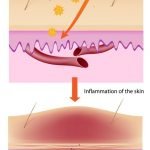A Geriatric Perspective on Type 2 Diabetes
Lucy Rojo, ND; Michael Almaraz, CCHT, NLP, RP
In the United States, there are 23.6 million people with diabetes mellitus. Of 17.9 million being diagnosed, 90% have type 2 diabetes mellitus (T2DM). The epidemic of T2DM comes with significant burdens on healthcare and financial resources, as well as on quality of life, often leading to increases in morbidity and premature death.
Type 2 diabetes mellitus is a chronic metabolic disorder that presents with a constellation of symptoms because of the inability of the body to manage glucose levels in the bloodstream. This is due to either the inefficiency or lack of insulin to adequately clear glucose from the blood and get it into the cells of the body. Compounding this inefficiency are cell membrane insulin receptors that do not adequately respond to circulating insulin. As a result, this may lead to a variety of metabolic reactions, including hyperinsulinemia, hyperlipidemia, and acidosis. Type 2 diabetes mellitus may represent an autoimmune disease that leads to the destruction of beta cells of the pancreas, the insulin producers of the body. Whichever circumstance exists, the end result is excess glucose in the blood, which leads to advanced glycation end products and improperly functioning tissues. By the time T2DM is diagnosed, which can be up to 25 years after the initial abnormal glucose fluctuations started, it is often too late to stop or reverse this destruction. Therefore, the main goals of naturopathic approaches are to reduce extreme blood glucose fluctuations, protect insulin-producing beta cells of the pancreas, and support circulation and proper function of the liver, the organ of glycogen storage and primary modulator of glucose output.
Caring for elderly individuals with T2DM requires an additional awareness on the part of the practitioner to appreciate impaired cognitive and physical function, including depression, dementia, anxiety, polypharmacy, and other comorbidities.1 In addition to these barriers, elders with diabetes often have less than optimal outcomes because of the sometimes multifaceted and complex treatment plans that NDs provide. So, when planning a comprehensive approach specific to T2DM, one must take care to simplify instructions and have clear goals that can be measured, monitored, and adjusted accordingly.
Laboratory Tests
Although the focus of T2DM is on blood glucose, it is important to remember that fat and protein metabolism is affected as well. While conventional testing often focuses on fasting blood glucose level, there are other tests that can further define the relationship between glucose and insulin. A fasting blood glucose level is a snapshot in time, while the glucose insulin tolerance test looks at the relative relationship between insulin and glucose during a period. Dysglycemia can be elucidated in response to a 70-g loading glucose drink due to highly excessive or insufficient insulin response. Retrospective recollection of patients with T2DM often reveals a history of dysglycemia years before a T2DM diagnosis. The glucose insulin tolerance test can be performed in 1-hour to 5-hour increments and can reveal hypoglycemic episodes due to reactive hypoglycemia, which can be detrimental for elders because hypoglycemic syncope can lead to immobilizing fractures.
To track the outcomes of interventions, fructosamine measures glucose control over a 1-month time frame, while glycated hemoglobin level elucidates control over a 3-month time frame. Deciding on the appropriate test depends on cost considerations, expected patient compliance with treatment, and the aggressiveness of tools used by the practitioner, whether conventional and/or natural approaches. Whichever monitoring tests are used, they should be performed every 3 to 6 months for at least the first year of naturopathic management, so patients and practitioners can better address less than optimal outcomes quicker and more aggressively. Much of the management of T2DM requires a team approach between patient and practitioner that involves regular follow-up care, education, and trust of all parties involved.
When a patient decides to incorporate a naturopathic approach, it helps to create a vision of how to assemble a team of experts, among whom the power is placed back into the patient’s hands as the “captain of the team.” While many patients may not wish to take on this role, it is a vital component in the successful long-term outcomes of T2DM; it is important that the practitioner should work at empowering the patient in the self-care and consciousness necessary to get a manageable handle on this disease process. As NDs, we are the teachers during the appointment, but much of the effort of this particular disease requires the patient’s active participation outside of the clinical setting.
With patients having T2DM, accountability for self-management is crucial and can improve their health outcomes. Ideally, proactive patients who take a responsible part in the management of their chronic condition require appropriate clinical, social, and emotional support, which is where the naturopathic model can shine. On starting the journey toward predefined parameters, it useful to offer a basic understanding of the disease process and healing modalities used before the patient can achieve optimal results. To facilitate a shift in thinking and belief about the situation, hypnosis can be a useful tool.
The Role of Hypnosis
Taking on a healthy low-glycemic diet and an active consistent exercise regimen can be the most difficult changes to achieve for patients with diabetes. Hypnosis already has a long history of helping people attain and maintain their ideal and healthy weight; weight control challenges are often inherent with T2DM. As a bonus, hypnosis helps the patient with diabetes more easily comply with instructions given by the physician. Hypnosis is most effective when used in conjunction with conventional healthcare and may be even more important with often complex treatment plans of well-meaning NDs. This therapeutic modality can change inner motivations, thereby lowering the desire for unhealthy food choices. A skilled hypnotherapist can also help a person increase his or her desire for better-quality foods, develop improved eating habits, and lower the overall amount of food intake.
Individualized guidance and customized visualizations of the glycemic load values being lowered may be achieved by accessing the subconscious mind. With this alone, some individuals are able to lower their laboratory values as much as 3 points, a truly mind-bending result. Hypnosis has the ability to convince the patient that something helpful, true, or accurate can exist outside of his or her established but sometimes disrupting belief system. When belief in something exists, that belief is reflected in one’s thoughts, feelings, and actions. With diabetes-specific hypnosis, the individual becomes more convinced on every level that he or she now prefers healthier foods and activities. All this in turn offers a new opportunity for a better quality of life and the ability to regain a freedom toward better health. With time, all the changes and individualized support create new habits and more-positive result-producing attitudes that help individuals manage their disease better for the long term.
Hypnosis is similar to removing a veil or a cover off of the subconscious mind. Through this process, self-created and perpetuated blocks can be dealt with in a gentle and permanent manner. Most people, but especially patients with T2DM, have conscious or unconscious mental blocks that they have created around food limitations, disease sentencing, and lack of control. While in a trance, patients can see, feel, or maybe just have a knowing that things are changing for the better and becoming different in their lives. As individuals agree to live healthier empowered lives, we cocreate habitual changes, and with repetition these will become their new lifestyle.
In addition to patients’ following dietary and exercise recommendations, their glucose level tends to stay much more consistently in range when the client takes an hour a day to apply the self-hypnosis techniques that are uniquely created by the hypnotherapist. These contain suggestions formulated to lower and maintain acceptable glucose levels. One consistent characteristic with both young and older clients that helps determine their success is how soon they find out they have diabetes and how soon they start modifying their foods, mindset, and lifestyle. The key to each client’s success will be consistency with what he or she is modifying.
The Role of Bioflavonoids
Several investigations have focused on the usefulness of resveratrol and pycnogenol in managing some of the many complications of T2DM. Resveratrol is a polyphenolic compound from grape skins and seeds. Pycnogenol, an extract from Pinus maritime, is a procyanidin. Both of these are bioflavonoids possess a variety of antidiabetes characteristics and have high oxygen radical absorption capacity (ORAC) values. A high ORAC food item has the capability to act as a potent antioxidant, capable of donating electrons to unpaired free radicals that would otherwise cause significant oxidative stress, particularly in the nerves, liver, and microcirculation of the retina and kidneys, where elevated glucose levels found in T2DM characteristically create macropathologic conditions.
Resveratrol has several characteristics that can reduce pathologic conditions associated with T2DM. Several animal and in vitro investigations have documented reduced damage to vulnerable tissues by resveratrol in protecting nerve and mesangial cell function and reducing aberrant insulin secretion, hyperalgesia, and fat-induced insulin resistance. A 2007 Indian study2 showed that 4 weeks of resveratrol supplementation significantly attenuated neuropathic pain in diabetic mice and decreased serum tumor necrosis factor levels. A 2005 in vitro study3 showed the usefulness of resveratrol to inhibit a crucial catalyst of transcriptional regulatory protein nuclear factor–êB activation, a known disruptor of insulin signaling, in the presence of free fatty acids and hypertrophied adipocytes. The implication is that resveratrol may reverse insulin resistance syndrome and atherogenesis. More recently, a 2011 Polish study4 showed that resveratrol decreased blood glucose levels in hyperglycemic mice by increasing intracellular transport. The article also suggested a protective effect by resveratrol on beta cells by inhibiting cytokine action and attenuating oxidative damage on the pancreas. In a 2011 Chinese in vitro study,5 an antioxidant effect of resveratrol was demonstrated on the mitochondria of mesangial cells, which has implications in diabetic nephropathy. Researchers were able to reverse the decrease of mitochondrial complex 3 activity in glucose-treated mesangial cells, a major cause of oxidative stress in kidney tissue. Finally, in a transgenic mouse model of Huntington’s disease, a disease associated with diabetes mellitus, investigators showed that resveratrol had neuroprotective effects on key sensor and effector proteins.6
Pycnogenol shows similar benefits in T2DM models. A 2010 Korean study7 demonstrated that pycnogenol enhanced uptake of glucose by adipocytes because of an increase in GLUT4, a pivotal glucose transport system. In a 2009 study8 in humans, early diabetic retinopathy was positively affected by the use of pycnogenol, showing visual improvement after only 2 months of supplementation, as demonstrated by improved retinal edema scores, retinal thickness, and laser Doppler flow velocity measurements at the central retinal artery.
Pycnogenol also enhanced microcirculation in the extremities. In a 2008 randomized double-blind placebo-controlled trial of patients having T2DM with mild to moderate hypertension and angiotensin-converting enzyme (ACE) inhibitor therapy, cardiovascular benefits were observed with the use of pycnogenol.9 At the end of 12 weeks of supplementation, the pycnogenol-treated group vs the ACE inhibitor–only group achieved significant improvements in many cardiovascular risk factors, including blood pressure (−58.3% vs −50%), mean glycated hemoglobin level (−0.8% vs −0.1%), fasting plasma glucose level (−23.7 vs −5.7 mg/dL), and low-density lipoprotein cholesterol level (−12.7 mg/dL in the pycnogenol group). Therefore, pycnogenol was shown to also offer multisystem benefits for diabetes control by lowering cardiovascular disease risk factors and by reducing antihypertensive medication use. Finally, in a 2006 German study,10 diabetic ulcers demonstrated 89% complete healing with systemic and local application of pycnogenol at 6 weeks (vs 84% for local pycnogenol alone, 85% for oral pycnogenol alone, and 61% for medicated controls), indicating better microcirculation.
Conclusion
Naturopathic physicians and licensed hypnotherapists are privileged to work with the healing power of nature as it continues to provide multifaceted tools that have broad applications on the complex biological and psychosocial nuances of T2DM. To date, it seems that the medical community is merely scratching the surface in its understanding and incorporation of these 2 arenas of complementary science into mainstream healing techniques. Hypnosis and the 2 potent antioxidant and anti-inflammatory bioflavonoids resveratrol and pycnogenol may offer complementary if not superior benefits relative to single-system polypharmacotherapeutics, in their apparent ability to target multiple body systems in the setting of T2DM.
 Lucy Rojo, ND is a naturopathic physician in private practice in southern California. She is on the clinical faculty of nutraMetrix Educational Institute, Greensboro, North Carolina, whose goal is to educate and enlighten health professionals on the role of nutrition and nutraceutical applications. Visit www.drlucyrojo.us.
Lucy Rojo, ND is a naturopathic physician in private practice in southern California. She is on the clinical faculty of nutraMetrix Educational Institute, Greensboro, North Carolina, whose goal is to educate and enlighten health professionals on the role of nutrition and nutraceutical applications. Visit www.drlucyrojo.us.
 Michael Almaraz, CCHT, NLP, RP has worked as a certified clinical hypnotherapist and neurolinguistic programmer at Deeper States Mind and Wellness, in Los Angeles, California, for more than 14 years.
Michael Almaraz, CCHT, NLP, RP has worked as a certified clinical hypnotherapist and neurolinguistic programmer at Deeper States Mind and Wellness, in Los Angeles, California, for more than 14 years.
References
- Alagiakrishnan K, Sclater A. Psychiatric disorders presenting in the elderly with type 2 diabetes mellitus [published online ahead of print October 10, 2011]. Am J Geriatr Psychiatry. doi:10.1097/JGP.0b013e31823038db. Medline:21989315
- Sharma S, Kulkarni SK, Chopra K. Effect of resveratrol, a polyphenolic phytoalexin, on thermal hyperalgesia in a mouse model of diabetic neuropathic pain. Fundam Clin Pharmacol. 2007;21(1):89-94.
- McCarty MF. Potential utility of natural polyphenols for reversing fat-induced insulin resistance. Med Hypotheses. 2005;64(3):628-635.
- Szkudelski T, Szkudelska K. Anti-diabetic effects of resveratrol. Ann N Y Acad Sci. 2011;1215:34-39.
- Xu Y, Nie L, Yin YG, et al. Resveratrol protects against hyperglycemia-induced oxidative damage to mitochondria by activating SIRT1 in rat mesangial cells [published online ahead of print October 10, 2011]. Toxicol Appl Pharmacol. doi:10.1016/j.taap.2011.09.028. Medline:22015446
- Pasinetti GM, Wang J, Marambaud P, et al. Neuroprotective and metabolic effects of resveratrol: therapeutic implications for Huntington’s disease and other neurodegenerative disorders. Exp Neurol. 2011;232(1):1-6.
- Lee HH, Kim KJ, Lee OH, Lee BY. Effect of pycnogenol on glucose transport in mature 3T3-L1 adipocytes. Phytother Res. 2010;24(8):1242-1249.
- Steigerwalt R, Belcaro G, Cesarone MR, et al. Pycnogenol improves microcirculation, retinal edema, and visual acuity in early diabetic retinopathy. J Ocul Pharmacol Ther. 2009;25(6):537-540.
- Zibadi S, Rohdewald PJ, Park D, Watson RR. Reduction of cardiovascular risk factors in subjects with type 2 diabetes by pycnogenol supplementation. Nutr Res. 2008;28(5):315-320.
- Belcaro G, Cesarone MR, Errichi BM, et al. Diabetic ulcers: microcirculatory improvement and faster healing with pycnogenol. Clin Appl Thromb Hemost. 2006;12(3):318-323.









